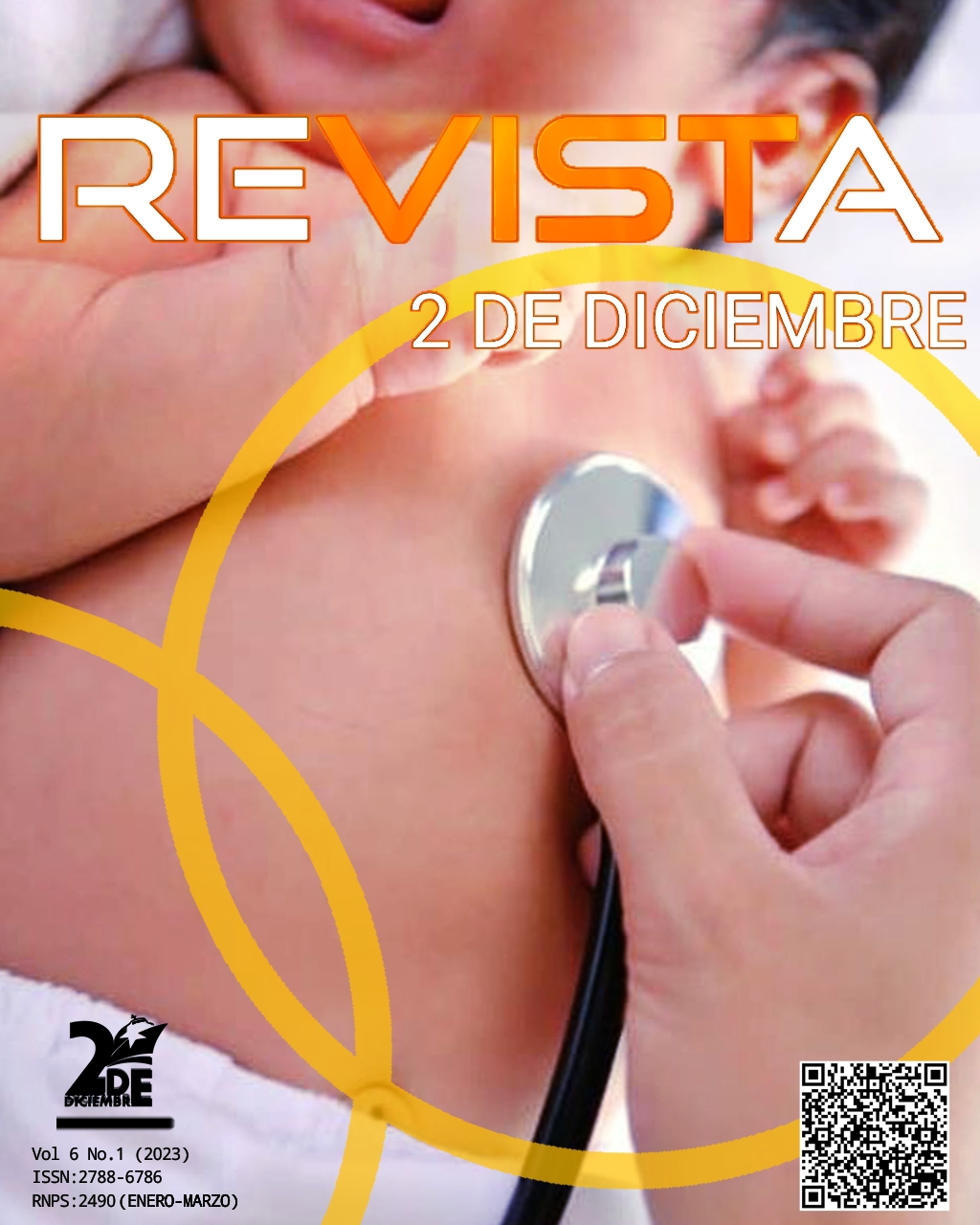Characterization of patients with intestinal invagination at the Hermanos Cordové Hospital in the period 2016-2018
Keywords:
Hydrocolon, Infants, Intestinal intussusception, Protocol, Risk factors, Therapy.Abstract
Introduction: intestinal invagination is the most frequent cause for intestinal obstruction in nursling and little kids; it consists on the slide of part of the intestine into another nearby distal intestine´s portion. Objective: to characterize patients with intestinal invagination according to epidemiological, analytical, radiological aspects and therapeutic behavior. Method: an observational, descriptive and retrospective study of patients who suffered from intussusception at the Hermanos Cordové Pediatric Hospital, during the period 2016-2018, was carried out. The population was made up of 28 patients, information was collected from medical records and hospital control records. It was processed through the calculation of percentages, arithmetic mean and standard deviation. The following variables were considered: age, sex, complementary tests and therapy. Results: the male sex (71.4%) predominated, which doubled the female sex, and the age group of 7-12 months (46.4%), with a mean age of 8.2 ± 4.7 months. The condition was directly related to risk factors such as Acute Respiratory Infections in 60.7%. The complete blood count was the one indicated for 100% of the infants and within the radiological ones the colon by enema and the simple Rx of the abdomen at 96.4%. Surgical reduction was performed in 64.3% of infants and hydrocolon in 3.6%. Conclusions: it is necessary to perfect the actions aimed at reducing the risk factors that predispose it, it constitutes a surgical emergency, which translates into operative risk and an increase in hospital costs.
Downloads
References
Mehendale S, Kumar CP, Venkatasubramanian S, Prasanna T. Intussusception in children aged less than five years. Indian J Pediatr. [Internet].2016 [citado 20 Jul 2020]; 83(1087-92). Disponible en: https://pubmed.ncbi.nlm.nih.gov/27211600/
Trotta F, Da Cas R, Bella A, Santuccio C, Salmaso S. Intussusception hospitalizations incidence in the pediatric population in Italy: a nationwide cross-sectional study. Ital J Pediatr. [Internet].2016 [citado 20 Jul 2020]; 42(89). Disponible en: https://www.ncbi.nlm.nih.gov/pmc/articles/PMC5039877/pdf/13052_2016_Article_298.pdf
Jenke AC, Klaassen Mielke R, Zilbauer M, Heininger U, Trampisch H, Wirth S. Intus susception: incidence and treatment-insights from the nationwide German survei llance. J Pediatr Gastroenterol Nutr [Internet].2011 [citado 20 Jul 2020]; 52(4): 446-51. Disponible en: https://pubmed.ncbi.nlm.nih.gov/21415671/
Simon Hasbun J. Cirugía Pediátrica: Obstrucción Intestinal (Invaginación y Enfermedad de Hirschsprung). Gazeta Mexicana de Cirugía Pediátrica [Internet].2016 [citado 22 Jul 2020]. Disponible en: https://es.slideshare.net/jihansimonhasbun1/ciruga-peditrica-obstruccin-intestinal-invaginacin-y-enfermedad-de-hirschsprung
Chien M, Willyerd FA, Mandeville K, Hostetler MA, Bulloch B. Management of the child after enema-reduced intussusception: hospital or home? J Emerg Med. [Internet].2013 [citado 22 Jul 2020]; 44: 53-7. Disponible en: https://pubmed.ncbi.nlm.nih.gov/22555056/
MENJÍVAR ESCALANTE EV, ESPINOZA FIALLOS EA, ROBLES TICAS JO. Guías Clínicas de Cirugía Pediátrica. MINISTERIO DE SALUD. [Internet].2016 [citado 22 Jul 2020]. Disponible en: http://asp.salud.gob.sv/regulacion/pdf/guia/guia_clinica_cirugia_pediatrica.pdf
Úbeda Obando FA. Tesis para optar al título de Especialista en Cirugía Pediátrica: “Experiencia de la desinvaginación hidrostática como tratamiento no quirúrgico en pacientes con invaginación intestinal, del servicio de emergencia del Hospital Infantil Manuel de Jesús Rivera “La Mascota”, en el período del 1 de enero 2013 al 31 de enero 2018.” Tesis para optar al título de Especialista en Cirugía Pediátrica. Managua [Internet].2018 [citado 22 Jul 2020]. Disponible en: https://repositorio.unan.edu.ni/9732/1/98429.pdf
Armenteros García A, Pascual Héctor AM, Alfonso Chang Y, Ballate Machado D, Esquivel Sosa L, Camacho Hernández O, et al. Reducción hidrostática en niños con invaginación intestinal. Medicent Electrón [Internet]. 2017 [citado 14 Feb 2019]; 21(3). Disponible: http://scielo.sld.cu/pdf/mdc/v21n3/mdc05317.pdf
Espinoza Vega ML, Martín Rivada A, Rico Espiñeira C, De Lucio Rodríguez M, Guillén Redondo P, Luis Huertas AL, et al. Recurrencia de la invaginación intestinal no complicada. ¿Es posible el manejo ambulatorio? Cir Pediatr. [Internet].2017 [citado 22 Jul 2020]; 30: 95-9. Disponible en: https://www.secipe.org/coldata/upload/revista/2017_30-2_95-99.pdf
Cárcamo Juarez DA, Craniotis Rios J. Invaginación intestinal en menores de 2 años de edad. Acta Pediátrica Hondureña [Internet].2016 [citado 22 Jul 2020]; 7(1). Disponible en: http://www.bvs.hn/APH/pdf/APHVol7/pdf/APHVol7-1-2016-6.pdf
Jiménez JH. Invaginación intestinal en pediatría. Revista Mexicana de Cirugía Pediátrica [Internet].2005 [citado 20 Jul 2020]; 12(4). Disponible en: https://www.medigraphic.com/pdfs/revmexcirped/mcp-2005/mcp054b.pdf
Abate H, Strugo L, Falaschi A. Aspectos clínicos y epidemiológicos de la invaginación intestinal en niños menores de2 años, de la provincia de Mendoza, Argentina. Arch Argent Pediatr [Internet].2006 [citado 16 Jul 2020]; 104(6): 496-500. Disponible en: https://www.sap.org.ar/docs/publicaciones/archivosarg/2006/v104n6a04.pdf
Apezteguía L, Dall’Orso P, García L, Piñeiro S, Giachetto G. Invaginación intestinal: Aspectos epidemiológicos y clínicos. Centro Hospitalario Pereira Rossell 2006-2010. Arch. Pediatr. Urug.? [Internet].2015? [citado? 21 Nov 2019];? 85(2): 68-73. Disponible en: http://www.scielo.edu.uy/pdf/adp/v85n2/v85n2a02.pdf
Balaguer Paniagua D, Rodríguez Iniesta R, Díaz Aranzabia D, Horneros Torres J, Tenesa Bordas M, Bechini Bernard J. Invaginación intestinal: Guía para la reducción hidrostática guiada por ecografía. Sociedad Española de Radiología Medica [Internet].2017 [citado 22 Jul 2020]. Disponible en: https://www.google.com/url?sa=t&rct=j&q=&esrc=s&source=web&cd=&cad=rja&uact=8&ved=2ahUKEwjlqqnfrebqAhUKJt8KHTlXB1sQFjADegQIAhAB&url=https%3A%2F%2Fpiper.espacioseram.com%2Findex.php%2Fseram%2Farticle%2Fdownload%2F125%2F119%2F&usg=AOvVaw1IJOcFiGGXAZ7j-mMmnWfK
Ortolá Fortes P, Domènech T? rrega A, Rodríguez Iglesias P, Rodríguez Caraballo L, Sangüesa Nebot C, Vila Carbó JJ. ¿Es posible el manejo ambulatorio de la invaginación intestinal? . Rev Pediatr Aten Primaria? [Internet].2017? [citado? 21 Nov 2019];? 19(75): 231-239. Disponible en: http://scielo.isciii.es/pdf/pap/v19n75/1139-7632-pap-20-75-00231.pdf
Vázquez Merayo E, Anido Escobar V, Vázquez Martínez YE, Vázquez Martínez YT. Invaginación intestinal en el niño, respuesta al tratamiento médico. Revista Cubana de Pediatría. [Internet].2015 [citado 31 Jul 2020]; 87(3): 265-72. Disponible en: http://scielo.sld.cu/pdf/ped/v87n3/ped02315.pdf
Downloads
Published
How to Cite
Issue
Section
License
Authors who have publications with this journal agree to the following terms: authors retain their copyright and grant the journal the right of first publication of their work, which is simultaneously subject to the Creative Commons Attribution-NonCommercial 4.0 International License that allows third parties to share the work as long as the author and first publication in this journal are indicated, for non-commercial use. Authors may adopt other non-exclusive license agreements for distribution of the published version of the work (e.g., depositing it in an institutional telematic archive or publishing it in a monographic volume) as long as the initial publication in this journal is indicated. Authors are allowed and encouraged to disseminate their work via the Internet (e.g., in institutional telematic archives, in their web page or in Pre-print servers) before and during the submission process, which can lead to interesting exchanges and increase citations of the published work. (See The Open Access Effect).







